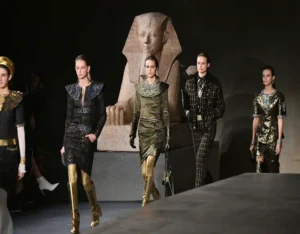PARIS! The fashion capital has set a benchmark in the world of designs and clothes. The French city has evolved a lot in the universe of style and fashion since the 16th century.
The French style, design, fragrances, accessories almost everything has been very much influential in the fashion world. The industry is so huge that it is considered to be as one of the most grossing industries in France as an integral part of its economy.

In Africa, it is Egypt and Nigeria that have been leading the fashion industry. The industries were estimated to generate $2.5 billion in revenue, last year in 2023. And interestingly, both the countries have approached differently to this lead.
Fashion in Africa
Egypt and Nigeria are the top nations behind the booming fashion industry in Africa, paving the way in its growth. With the generation of $2.5 billion, collected as a yearly revenue in fashion, last year, the two has become the most favourable cities to look for fashion.

Change brought by Nigeria through Fashion
Nigeria’s fashion industry has a long and rich history, recalling back to pre-colonial times when different ethnic groups developed their distinctive clothing styles using local fabrics and embellishments.
Though the industry was not that much large or profitable back in early 60’s. The style caught on shortly after, when the industry experienced a surge of creativity and innovation.
Back then, fashion was a blend of traditional and modern styles, which was more influenced by the colonialism, globalization and modernization. Growth in demand for the domestic and international items were seen by the 1980s and 1990s, as the fashion industry witnessed a boom with the introduction of ready-to-wear clothing by local designers.

During that time, the demand increased from domestic and international markets. As per the facts presented by PwC, Fashion industry of Nigeria estimated its value at $50 million in 1991, recording a significant increase from $10 million, which was seen in 1985.
Slowly, as the years went by, factors such as economic recession, political instability and import restrictions made the industry take a back seat. The consistent inflationary situations made the demand for fashion items fluctuate.
In Nigeria, fashion game has always been a melting pot of cultures and external influences. It is a complex and ever-changing industry that is influenced by a variety of factors. Such as in the mid-2010s, there came a renewed interest in African culture and heritage that ignited the interest in indigenous African pieces.

Nigeria has accounted for 15% of a $31 billion fashion market in Sub-Saharan Africa in the year 2015, and the industry grew to 17% between 2010 and 2019.
The entertainment industry is the main reason, especially the Afrobeat stars, who brought attention of everyone towards Nigerian Fashion. Global trends and innovations, mainly shape Nigeria’s fashion industry.
The trend popularised vintage thrift outfits during the TikTok y2k. reports by Statista also reveals that Nigeria’s resale market is rapidly expanding, and reflecting the growing importance of circular fashion for environmentally conscious consumers.
Industrial Revolution in Egypt Fashion
Fashion industry of Egypt is more likely inclined towards technical edges. Renowned for their exceptional cotton production, the industrial prowess of the country has been a consistent hallmark.
Back in 2009 and 2010, Egypt signed contracts with 23 international countries for cotton exports, worth $140 million. However, the North African country has always been a leader in the industrial revolution, with manufacturing of apparels being at front and centre.

Despite of occasional setbacks, Egypt has always maintained a position ahead of much of other African countries, ranking well in the industrial achievements.
Egypt is recently focusing over manufacturing and involved the establishment of thousands of factories that has enhanced their industrial strength. The country is on its way to set up the world’s largest textiles factory, and is ready to produce 30 tons of textile daily in Mahalla.
Investment of Egypt extended to the sectors complementary to fashion along with tourism. With more than seven million tourists in H1 2023. Status of Egypt as a premier tourist destination complements the growth of the industry.
The inaugural fashion week of event drew the global fashion leaders of the Egypt by expanding the market. Journalists of Egypt – Mirna Abdulaal and Farah Sadek poised that nation would have been able to host such a grand event if it weren’t for its burgeoning market, which witnessed the significant growth over the years.

Apparel Export Council of Egypt revealed that the country’s fashion exports has seen a rise by 41% in the year 2021, collecting $2.49 billion, in the industry.
Perhaps, the demand declared that why Egypt is home to several fashion tech startups that facilitate the designer-customer connections and make African fashion more accessible.
Egypt hosted 11 operational fashion tech startups. One of these platforms was Gahez, that connects local fashion designers and manufacturers with the customers. Another platform was La reina, that allowed Egyptian women to rent the designer outfits for special occasions.
Both Egypt and Nigeria exemplify the diversity and dynamism within Africa’s fashion scene. Egypt’s economy is currently the second largest in Africa with $363.1 billion in nominal GDP, right behind Nigeria’s $432 billion.
Considerably, the countries have a growing young population with an increase of disposable income, and the most preferable fashion hubs of Africa. From Dakar to Ethiopia, poised for a global takeover.

